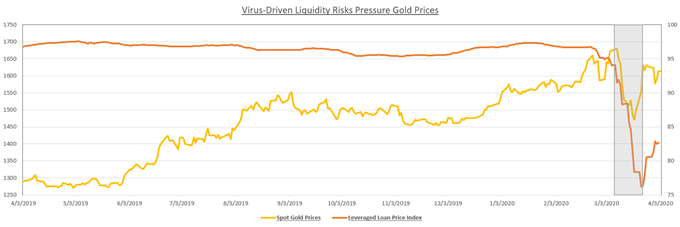GOLD PRICE OUTLOOK: BEARISH
- Gold prices may suffer if FOMC minutes spark risk aversion, concerns about liquidity
- XAU/USD could face additional selling pressure if employment data sours sentiment
- Ballooning credit risks from distressed corporate debt markets may cap gold’s gains
Gold Prices May Fall on FOMC Minutes
Gold prices could suffer after the minutes from the Federal Reserve’s emergency meeting on March 15 are released. That day, Chairman Jerome Powell announced that the central bank cut itstarget range for its benchmark Fed Funds interest rate to 0.00-0.25 percent. He also announced a $700 billion quantitative easing program (QE) with $200 billion dedicated to mortgage-backed securities and $500 allocated to Treasuries.
Gold Prices – Weekly Chart
XAU/USD chart created using TradingView
While the Fed’s intention was to help bolster confidence and provide liquidity, their actions were met in turn with risk aversion. This may be because the Fed’s policies were read by investors as an acknowledgement of how dire the circumstances were that it would require credit-easing policies of that magnitude. Following the announcement, gold prices fell as demand for liquidity surged and pushed the haven-linked US Dollar higher.
This is because gold’s appeal as an anti-fiat hedge was undermined after the Fed cut interest rates to zero and led investors to question the utility of holding a comparatively illiquid asset. Gold prices may therefore suffer after the FOMC meeting minutes are released if the underlying text sends a chilling effect across markets and recreates a similar market dynamic investors saw on March 15.
XAU/USD May Retreat if Credit Risks Amplify Liquidity Concerns
The yellow metal may face additional selling pressure if signs of an ever-increasing distressed corporate debt market spark fears of a credit crunch. As outlined in my piece on liquidity risks, the so-called leveraged loan market – and its securitization into so-called collateralized loan obligations (CLOs) – is threatening to destabilize already-battered financial markets and deepen a recession.
Source: Bloomberg
The spread on credit default swaps (CDS) for ensuring sub-investment grade corporate debt all over the world has skyrocketed, particularly in Europe where they are at levels not seen since the sovereign debt crisis. In fact, ECB policymakerYannis Stournaras recently warned that the region faces a similar risk again and warned that an onslaught of “soured loans” on banks’ balance sheets could deepen the coronavirus-induced recession.
Gold May Face Additional Selling Pressure From US Jobless Claims, Sentiment Data
The risk-off dynamic and worries about a global recession may be amplified by the publication of employment and sentiment data out of the world’s largest economy. Last week, US jobless claims statistics broke another record high with over 6.64 million filing for unemployment, dwarfing the prior week’s 3.28 million print. Another record-breaking figure could trigger a similar cross-asset selloff and pressure gold prices.
Source: Bloomberg
University of Michigan data may also irritate the yellow metal with preliminary figures for April showing an 81 expected print, down from the final March reading at 89.1. Given that over 70 percent of the US economy is driven by consumption, a change in the behavioral disposition of consumers has worrying implications. Speaker of the House Nancy Pelosi referred to consumers as the “lifeblood of our economy”.
$2 Trillion US Fiscal Stimulus Package May Not Be Enough to Stave Off Recession
The US now has the highest number of confirmed coronavirus cases totaling over 238,800 and has even surpassed China. Having said that, US intelligence agencies and market participants have questioned the legitimacy of Beijing’s reports. In response to the pandemic, US lawmakers passed a $2 trillion fiscal stimulus package that included direct checks to qualifying Americans and loans to distressed businesses.
Chart Showing Total Number of Coronavirus Cases
Source: John’s Hopkins CSSE
While gold prices initially rallied on the prospect of Democrats and Republicans working together to pass the Coronavirus Aid, Relief, and Economic Security (CARES) Act, those gains may not hold. With expectations of higher unemployment, notable policymakers like Mrs. Pelosi have already proposed working on another multi-trillion-dollar stimulus package with provisions dedicated to infrastructure.
However, Treasury Secretary Steven Mnuchin and US President Donald Trump said that planning another fiscal stimulus package may not be needed. Furthermore, Senate Republicans and House Democrats may find it difficult to reach a consensus as the latter is leaning towards expanding unemployment benefits with the former pushing back against such measures. Signs of political stress and delays could end up hurting gold.
Gold Price Decline May be Buffered by Supply Shock
Virus-induced supply disruptions may be able to mitigate XAU/USD’s losses. On March 25, South Africa, home to the Rand Refinery – the world’s largest metals processing outfit – announced a 21-day lockdown. While this particular facility has been exempted from a complete shutdown, bullion production will be “significantly scaled down”. An extended duration of the government’s shelter-in-place orders could push gold prices higher.
GOLD TRADING RESOURCES
— Written by Dimitri Zabelin, Jr Currency Analyst for DailyFX.com
To contact Dimitri, use the comments section below or @ZabelinDimitrion Twitter






Be the first to comment